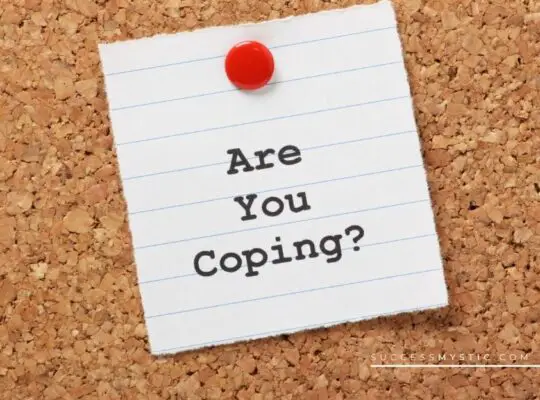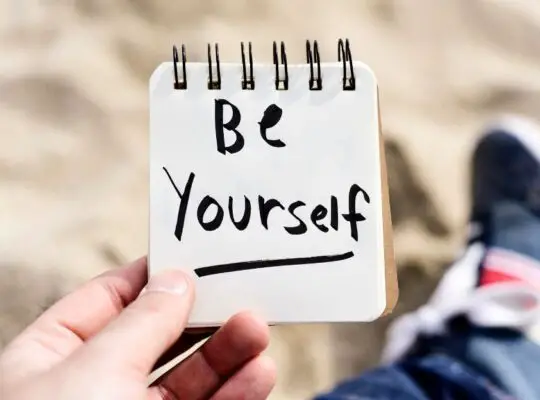In this article: How rituals can help you regain a sense of control, promote emotional balance, provide meaning and structure to life.
Introduction To Rituals
Rituals serve to help humans celebrate special occasions, move from one phase of life to another, and impose control over aspects of life that may feel out of their control. The Merriam-Webster thesaurus lists these synonyms for the word ritual:
- Custom
- Practice
- Habit
- Ceremony
- Observance
- Rite
Despite many different names, rituals all include activities with movements, words, actions, or objects performed in a set pattern. A ritual can be a small daily practice, specific and personal only to the person performing it. A ritual can also be a cultural or religious practice performed by family members or groups.
Some rituals, like holiday gatherings, are performed widely across social groups, even if the exact elements of the ritual differences from sub-group to sub-group. Thanksgiving Day dinner is an example of a social ritual. The gathering’s food and details often differ based on preference or culture, but most Americans perform some form of Thanksgiving dinner ritual.
The Study of Rituals
Psychologists have begun to study the social impact of rituals and the phycology of why people perform them. According to a study in Personality and Social Psychology Review, rituals have three primary functions.
- Regulate Emotions
- Improve Performance
- Increase Social Connection
Researchers believe that these three functions often overlap each other, meaning that a ritual can have more than one function. A study in American Anthropologist equated rituals with a feedback loop that resolves discrepancies between a psychosocial state and an ideal state. When something interrupts a person’s or a group of peoples’ psychological state, for example, a birth or death, rituals restore balance to their emotions.
Although some animals perform ritualistic behaviors, rituals are considered to be a uniquely human concept. According to a study in the Oxford Press, rituals contain symbolism, sacredness, and traditionalism.
Researchers also note that at least some parts of rituals are non-instrumental for performance. Unlike a pre-performance sports routine that may include stretching or other ways to warm up the muscles, many elements of rituals are not directly correlated to physical preparation.
Another study in Personality and Social Psychology Review cites how rituals are used to improve behavior and performance. These researchers found that teachers, parents, and others in authority can use rituals to motivate personal change in others. People are more likely to change after performing a ritual with personal meaning to them.
Rituals also help form people into a society. In the Elementary Forms of Religious Life, the author and researcher found that group rituals allow people to feel collective unity with other group members. A study in Biological Theory states that rituals are central to functioning among large groups. Rituals bring people together and help people work together regardless of their differences.
Scientists at the University of Toronto also found that rituals help people manage anxiety because rituals provide a sense of control. In an experiment, these researchers told participants they had to present information about an art sculpture to a group of angry judges.
They recorded the participants’ hand movements through specially wired wristbands. The researchers determined that the most anxious participants repeatedly performed ritualistic actions while holding and displaying the sculpture. The movement rituals give the participants a feeling of control about their presentations.
In helping to alleviate performance anxiety, rituals perform both the control and performance functions.
These benefits are linked to the anxiety reduction found in rituals:
- Delay
- Improve Concentration
- Improve Control
- Increase Motivation
A delay in beginning the performance, even for a short ritual, can provide the time needed to concentrate on the task. With an improved sense of control, motivation to perform the task increases. In a study in Organizational and Human Decision-Making Processes, researchers found that rituals improved a variety of sports performance tasks.
Basketball players who use pre-performance rituals before attempting a free-throw have a higher success rate than athletes who don’t use a ritual. Multiple studies have shown improved performance in basketball and golf with the use of rituals. Elite athletes, who may have higher performance goals and more anxiety than novice players, have longer and more complicated pre-performance rituals.
In the Journal of Consumer Psychology, researchers found that anxiety negatively affects motivation and self-efficacy, or the belief that a person can successfully complete a task. Low self-efficacy then reduces decision-making ability and, ultimately, behavior. When pre-performance rituals are used to reduce anxiety, the overall process of performance improves.
Rituals and the Brain
When a person doesn’t perform to their expectations, the brain responds in the anterior cingulate cortex’s dorsal region. A brain waveform, known as the error-related negativity (ERN) system, changes as a person notices their mistakes.
In a study in the Journal of Experimental Psychology, researchers found that performance errors also elicit an emotional response along with these brain wave changes. Working as another type of feedback loop, the ERN processes what a person notices about their performance. It eitherhelps them adjust their behavior or becomes overwhelmed with negative emotions, further decreasing their performance.
In a peer-reviewed study in PeerJ, researchers concluded that rituals have psychological and neural associations to performance functions. Rituals develop meaning over time, building a psychological connection between the ritual and success.
A ritual then acts to decrease performance anxiety. Decreased performance anxiety often improves the overall performance.
In a series of studies conducted by Harvard University, researchers tested the use of rituals on performance anxiety. They found that rituals are an effective strategy for reducing performance anxiety. They also found that rituals improved performance anxiety when done both by a group of people or by a single individual.
In a study conducted in Brazil, researchers studied simpatias – rituals believed to solve problems like quitting smoking or curing an illness. People’s perception of how well a simpatias works depends on how many steps are involved, how the steps are repeated, and if the ritual is performed at a certain time.
Society has connected these rituals to improvements in people’s lives, giving them greater weight the more involved they are. Following the rituals closely may be the link between the ritual and a person’s performance.
Rituals and Belief
The power of rituals isn’t only in a person’s belief that the ritual will work. The function of rituals includesprovidinga feelingof control after a loss. To determine if belief in rituals makes them more effective, researchers at Harvard University conducted an experiment.
To create a sense of loss, the researchers randomly gave $200 to one participant in a group of college students. That person was allowed to leave while the rest stayed, feeling the loss of not having received the money.
Half the group drew a picture about the loss, while the other drew a picture and performed a ritual including sprinkling salt on the picture, tearing it up, and silently counting to ten. The group that performed the ritual reported greater feelings of control and less intense feelings of being upset than the other group.
The ritual performing group included participants who practiced other rituals in their life and those who did not. Both types of participants benefited from the ritual, whether they commonly used them or not.
Ritual Events Found In Society
Society marks significant life events with rituals to build group cohesiveness. These rituals serve as ways people can express and manage their emotions about a life event. Rituals also help people prepare for a new stage of life and the behavior that will be expected of them during that time. Life events that rely heavily on ritual include:
- Birth
- Coming of Age
- Holidays
- Death
Religious rituals often have these functions and may include a focus on behavior and performance. Religious rituals and those performed for life events have psychological components regarding the reasons for the rituals. The specific activities and ingredients of the rituals may also have a psychological basis.
Religious Rituals
History shows that all human societies have rituals. A study in Religion, Brain, and Behavior states that religious rituals are pervasive throughout society because they provide social and psychological advantages to those performing the rituals. Regardless of religious belief or sect, common religious rituals include:
- Prayer
- Fasting
- Meditation
- Ceremonial Cleansing
- Pilgrimages
- Religious Holidays
- Ritual Sex
Performing religious rituals provides increased social standing. Following complicated or lengthy rituals like fasting or a pilgrimage highlights a person’s self-control and commitment. They show a person’s willingness to follow the religion’s teachings and expectations.
This may improve their social standing within the religious group. These rituals not only improve self-control and performance in an individual’s brain, but they also provide the psychological benefit of positive self-esteem for mastering and committing to the ritual.
Religious rituals also play a role in altering and improving perception. A study conducted by researchers at the University of Amsterdam asked Dutch Christians to pray for a person in need. Because Christianity’s view of God is generally favorable, the researchers proposed that the positive feeling derived from prayer would carry over to other areas.
After praying, the participants were asked to judge a series of people. As proposed, after prayer, the participants viewed other people more favorably. A separate study in the Journal of Personality and Social Psychology found that mediation had a similar positive effect on perception.
Perhaps the most fundamental function of religious rituals is to improve self-regulation and performance. To answer the question of how religious ritual motivates people to live a better life, a study in Frontiers in Psychology reported that mindfulness derived from religious rituals promoted coherence between explicit and implicit processes.
Self-regulation or self-control is the key to balancing emotional, psychological, and mental desires with physical behavior.
A meta-analysis in Personality and Social Psychology Review showed that people with more self-control are better at forming habits or implicit processes that help them act. People with more self-control are also better at creating explicit strategies to reach their goals, like making a plan, increasing their knowledge and abilities, and managing challenges.
A Social and Personality Psychology Compass studyfound that all religious traditions value inner peace, another critical factor in self-regulation. By helping to resolve inner conflicts, religious rituals can provide inner peace that improves self-control. Performing religious rituals, including mediation, prayer, fasting, and ceremonial cleansing, reinforces self-control through multiple routes.
Another aspect of religious rituals is those that are considered extreme because they require the participant to engage in bodily harm to show their devotion or commitment.
These bodily harm rituals include:
- Female Genital Mutilation
- Self-flagellation
- Impaling
- Baby Tossing
- Finger Amputation
- Fire Walking
- Human Sacrifice
While not common, these rituals are practiced in parts of the world today. Self-flagellation is the act of flogging oneself with a whip. Impaling involves piercing body parts with sharp objects. Baby tossing is a good luck ritual where elders toss babies from a temple roof to men below holding sheets. Even human sacrifice, although banned, is still practiced today.
Believers often witness these extreme rituals during elaborate ceremonies. A field experiment described in the Journal of Economic Psychology found that witnessing an extreme ritual affects the observers’ moral behavior. As a form of ceremonial cleansing, extreme rituals provide a group catharsis that induces moral clarity and regulates behavior after the ritual.
Birth Rituals
Pregnancy includes psychological aspects for both parents. In general, scientists believe pregnancy is a developmental phase that forces people to find adaptive solutions to childhood wishes and unresolved conflicts. Research work done by Erik Erickson and studies from the Journal of American Psychoanalysis Association shows that while parents influence their children, the process of having a child also influences the parents’ psychological development. Rituals during this period help people successfully move through this development phase.
Most pregnancy rituals attempt to provide a sense of control for the parents. While cultural transitions differ, a study conducted by the Southern Clinics of Istanbul Eurasia cited some common ritual and beliefs, including:
- Signs that Determine a Baby’s Sex
- Level of Physical Activity
- Birth Details that Predict Life Outcomes
Many people believe that how a baby is carried, either high or low, determines the baby’s sex during pregnancy. Others perform rituals like dangling a needle on a string above a pregnant woman’s belly, believing how the needle swings determine the baby’s sex.
Despite doctor’s recommendations, many women hold ritual beliefs about how much activity to engage in while pregnant, thinking their activity level will affect the baby’s health or the ease of birth. When a baby is born, the date and timeare also believed to determine a person’s outcome in life. These types of rituals can either comfort or distress new parents, depending on the result of the ritual.
A baby shower is a practical way to supply necessary items for expectant parents. Psychologically, it can affect parents’ self-esteem depending on the number and quality of the gifts received. A baby shower is also a way to form a social connection for the child, even before it is born. Religious rituals like circumcision and baptism further promote the child’s social inclusion.
During birth, rituals designed for comfort and protection may be included in the birthing process. Prayer or having religious books in the room are rituals that are thought to ward off evil spirits or bless the birth. Some parents chose to give birth at home. While this choice has many aspects, part of the decision may be based on family or cultural rituals for control, protection, and luck.
Psychologists have also determined that mother’s interactions with their newborn children are a ritualistic experience. During these interactions, parents and children perform rituals that:
- Get Attention
- Have Rules
- Follow Steps
- Are Formal
- Build Social Connections
Researchers at Southern Louisiana University describe parent-infant rituals as being primarily about taking turns. When parents and infants interact, they take turns focusing on and reacting to each other. Taking turns creates rules that govern the interaction. These interactions also promote the child’s overall development and social understanding.
To demonstrate the importance of these rituals, researchers observed mothers and infants interacting with each other. When a child made sounds, movements, or focused on the mothers, the mothersthen responded to the infant’s actions. Then it was the infant’s turn to react to their mother’s actions.
Once this turn-taking was established, if the mother stared quietly at the infant instead of taking turns responding, the child became upset and distressed. The infant would turn away from their mother, then try to re-engage them with a smile or other positive action. This adherence to ritual and the distressed caused by not following the rules can be observed in infants as young as two months old.
Stillbirths have their own rituals. According to a Journal of Clinical Nursing study, stillborn rituals have developed to benefit both the deceased child and the family.
Based on data gathered from UNICEF, the World Health Organization, and the Centers for Disease Control, the stillborn rate reflects the toll taken on families.
- Worldwide, over 7000 stillbirths happen each year.
- One stillbirth happens every 16 seconds.
- In the United States, one of every 160 births is stillborn.
- 24,000 stillbirths occur each year.
- Stillbirths account for ten times more deaths than Sudden Infant Death Syndrome (SIDS).
Although most stillbirths occur in developing countries, they do occur globally. To benefit the deceased child, stillbirth rituals are performed to provide the following benefits:
- Send the baby’s spirit to a safe place
- Protect the baby’s spirit from suffering
- Prepare the baby’s spirit for reincarnation or rebirth.
These rituals provide comfort to the family by giving them a feeling of control over the baby’s spirit. Family rituals offer these psychological benefits:
- Release Guilt
- Closure
- Avoiding Future Misfortune
Performing stillbirth rituals like holding a funeral or memorial service release parents from possible guilt over not raising their child. Stillbirth rituals also provide the closure that acknowledges the child’s existence and departure from this world. By performing stillbirth rituals, parents hope to improve performance and avoid the future misfortune of another stillbirth.
Coming Of Age Rituals
Coming of age refers to an event that marks a child’s transformation to adulthood. In ancient cultures, this often meant the first hunting kill for boys and the start of menses for girls. Today, coming-of-age rituals vary by cultural and social groups. Some typical coming of age rituals and events include:
- Earning a Driver’s License
- Drinking Age
- Having a Mustache or Needing to Shave
- Age of Legal adulthood
- Bar or Bat Mitzvah
- Confirmation
- Quinceanera
- Sweet 16
Not every adolescent participates in each of these rituals. No everyone earns a driver’s license at the same age, nor is there a traditional ceremony for it. The age of legal adulthood differs from country to country, although 18 years of age is the most common. Ceremonies like Bar or Bat Mitzvahs, confirmations, and quinceaneras are specific to cultural and religious groups. Sweet 16 parties are reserved for females.
Some sociologists and psychologists have expressed concern over the lack of a universal coming of age ritual. A study in American Psychologist found that the lack of a universally accepted coming of age ritual in the United States does not help children transition into adulthood.
The wide variety of rituals creates confusion as to what, exactly, constitutes adulthood. The legal age of adulthood does not consider the skills or abilities of adolescents to function as adults in society effectively.
When coming of age rituals are performed, the researchers found that they fulfill these psychological functions:
- Acknowledge Status Change
- Transfer Knowledge and Responsibility
- Social Acceptance
By acknowledging the status change from child to adult, coming of age rituals provide improved self-esteem. By transferring knowledge and responsibility, the rituals provide expectations for performance.
Having a ceremony includes the person as an adult in cultural and social groups. Psychologically, coming-of-age rituals help people define themselves, build self-reliance, and build compassion through social identity.
Holiday Rituals
According to researchers at the University of Texas Health Center, holiday rituals provide a sense of control, joy, enhance a sense of self, and give structure and meaning to life.
Laboratory experiments in Organizational Behavior in Human Decision Processes and field studies in American Anthropologist show these benefits of performing traditional holiday rituals:
- Reduce Stress
- Predictability
- Social Connection
- Belonging
- Generosity
Regardless of how stressful life is throughout the year, holiday rituals reduce stress because they provide predictable activities during specific times. Holiday rituals offer hope that some parts of the year will happen in a predictable pattern. Even everyday activities, like meals, are more meaningful when performed as holiday rituals.
Because holiday meals are usually elaborate, they require increased time to prepare and cook. These activities offer the opportunity to create and reinforce social and community connections. The conversations people have during holiday meal preparation also help build connections. People who do not normally connect during other times of the year have the opportunity during ritual holiday gatherings. This opportunity’s psychological importance is highlighted by the fact that more people travel during the holiday season at the end of the year than during any other period.
Consuming food during a ritual can also be more satisfying than eating without a ritual experience. Researchers at the University of Minnesota found that when participants performed a ritual to open and eat a chocolate bar, they reported that the candy tasted better and was more enjoyable.
In another experiment, participants who performed a ritual before and while eating a candy bar perceived that it was more expensive and desirable. People felt foods other than chocolate also tasted better when eaten with a ritual, including raw carrots.
Scientists believe that rituals associated with food and eating provide more enjoyment because they immerse people in the experience.
The ritual of giving gifts provides social connection and status when two people or a group of people chose to exchange gifts. Being part of the group that trades gifts also reinforces a sense of identity and fills the need for belonging. Gift giving, whether it is reciprocal or not, reflects compassion and generosity.
Holiday decorating may help people recall memories that induce healing. Usingtraditional or ritual objects for decorating may remind people of lost loved ones or happy times in the past. Displaying decorations also provides self and social validation.
Common ritual objects used as holiday decorations may include:
- Christmas Trees
- Menorahs
- Lights
- Wreaths
- Hearts
- Party hats
- Shamrocks
- Flags
- Pumpkins
- Turkeys
While some of these objects are religious symbols, their meaning and use are a part of social norms and customs. When a group of people uses the same decorations, group and social identity are reinforced. Highlighting elaborate decorative displays and positive comments about them from others improves self-esteem.
According to researchers at the University of California Berkley, changes to holiday rituals can elicit moral outrage, a powerful psychological response to change. Holiday rituals are rooted in what a group values, often family, community, and kindness.
Performing holiday rituals are viewed as acts of love by participants and observers. The researchers found that the more ritualistic the holiday, the stronger the sense of moral outrage associated with changes.
In an experiment, participants were asked to rate how ritualistic various holidays were to them. Then they were asked to rate how angry they would be if the government moved the date of the holidays. After rating both questions on a one to seven scale, Christmas and New Year’s scored above five for both questions.
The higher the corresponding numbers, the greater the sense of moral outrage about changing it. Columbus Day, for example, scored a two on both questions, signifying little moral outrage about this less ritualistic holiday.
Even changes for safety can elicit moral outrage related to rituals. In another experiment, researchers asked a group of Jewish people how they would feel if the ritual of circumcision was moved from a temple to a hospital. Circumcision is a highly ritualistic religious ceremony that has been performed for thousands of years. Although 80% of participants felt a hospital setting was safer, they also expressed moral outrage at not strictly following the ritual by using a hospital instead of a temple.
Death And Funeral Rituals
Humans have used death and funeral since our earliest history. Anthropologists have found evidence of funeral rituals as far back as the Neanderthals.
According to psychologists, funeral rituals serve these functions:
- Relieve Guilt
- Performance
- Reduce Anxiety
- Control
- Express Emotions
Not only a way to show love, the idea of the “perfect funeral” also relieves people of guilt for any mistreatment they have done to the deceased. Researchers at the University of North Texas found that families who held what they believed was the perfect funeral, or one that went according to plan and showed great love for the deceased, had considerably less unresolved grief.
Religious funeral rites often focus on preparing the deceased for the afterlife. The Egyptians buried their dead with everything needed for the next life, including food and riches. This practice was also common among the Vikings, the Celts, and in ancient China.
Christian funerals involve asking God to give the deceased peace in the afterlife. By following a funeral ritual, people feel their performance improves the deceased’s opportunity after death.
Researchers at the University of Connecticut found that ritualistic funeral behaviors reduced anxiety. And regardless of what religious or non-religious rituals people performed, funeral rituals gave them a sense of control.
Death can bring change and upheaval to peoples’ lives. They may fear that the death of a loved one means loss of:
- Companionship
- Social Status or Identity
- Income
Losing a partner or friend leaves a void of companionship. Society re-labels those who have lost someone to death with terms like widow or widower and orphan. The loss of their partner’s income can also create anxiety. The researchers found that ritual funeral practices gave people a sense of control and safety.
Studies in PSYCHOLOGS explain that crying is a reaction to the sympathetic nervous system’s response to stress. Prolonged crying increases heart rate, causes sweating and lowers the rate of breathing.
Mourners may experience the same chemical imbalances as people with anxiety and mood disorders, including changes in the amount or balance of:
- Serotonin
- Dopamine
- Norepinephrine
- Gama-aminobutyric
The imbalance of these neurotransmitter chemicals may create panic and stress disorders. Mourners may exhibit physical symptoms such as:
- Aches
- Sprains
- Loss of Appetite
- Insomnia
- Vomiting
- Headache
- Abdominal Pain
The researchers found that funeral rituals help shorten the stress stage caused by a loved one’s death. Funeral rituals offer healing stimuli and powerful psychological healing.
The objects or elements of funeral rituals may vary due to religion or culture, but many typical funeral elements help provide emotional healing.
These common elements may include:
- Facial Expressions and Body Language of Other Mourners
- Music, Chanting or Singing
- Incense or the Smell of Flowers
- Hugging
- Pampering
- Natural Environment
Other mourners’ facial expressions and body language are strong visual stimuli that can improve the chemical imbalance in the brain. When other mourners appear calm and composed, these feelings can transfer to the bereaved.
Auditory stimuli like music may provide a sense of calmness and peace. Scents like incense or flowers may also serve this function. Hugging and pampering are physical and emotional expressions of social connection, despite grief and possible group status change. Pampering is also a subtle reinforcement that the bereaved have a right and need to grieve.
Holding the burial at a park-like setting in a cemetery or releasing ashes in nature allows the natural environment to calm and soothe the mourner’s emotions. A study in Frontiers in Psychology found that time spent in nature promotes a beneficial psychological response by improving a person’s mood and concentration.
A study conducted by Harvard University looked more closely at the specific types and elements of funeral rituals. They also studied the effects of belief in funeral rituals on their ability to help people. In one experiment, they asked participants to write about a significant loss in their lives, either a death or the end of a relationship.
A subgroup of participants was also asked to write about any rituals they performed after this loss. The group that wrote both about their loss and the rituals they performed showed significantly greater feelings of control about the situation. While a study in the Handbook of Health Psychology noted that writing about loss has psychological benefits, this study showed that writing about both loss and rituals associated with that loss had an even more significant benefit.
In another experiment, participants were asked how often they usually performed any type of ritual behavior. Those who rarely or never performed rituals were categorized as having a low belief in the effectiveness of rituals.
Then researchers created a loss scenario by giving one participant money. The participants who did not receive the money were asked to either write about the loss or to write about the loss then ritualistically destroy their writing. Those who performed the destruction ritual reported a greater sense of control, regardless of whetheror not they previously believed in rituals.
In a third experiment, participants who had recently experienced a loss were told that people often sit in silence after a loss. A sub-group of participants then sat in silence, while the rest did not. This experiment aimed to determine if knowing about a ritual was as powerful as performing it.
The researchers found that the participants who sat in silence reported a greater sense of control and less feeling of loss than those who only know about the ritual. The researchers concluded that performing a ritual is a key factor in making the ritual work as intended. Because sitting in silence is not a common grief ritual, the researchers also believe that exact the elements of a ritual are not as essential as the ritual experience itself.
How Rituals Can Help Your Well-being and Personal Growth
When you think about rituals, you probably think about chanting or prayer, celebrations on the full moon, perhaps a cultural wedding, or even an offering to a god. A lot of us immediately think of religion when someone mentions rituals. While there are a lot of rituals tied to religion, they are more than prayers or religious ceremonies.
Rituals, believe it or not, are present in your everyday life. Humans have an inherently ritualistic nature, whether we are aware we are doing it or not. By overlooking those rituals, though, we do them mindlessly thus lose the benefit and take them for granted. When you perform a ritual with purpose and it is tied to beliefs, values, or things that are important to you, they are incredibly powerful.
Our modern culture pressures us to believe that we need to be constantly satisfied with life. That we need to be happy always. That we need to strive for perfection. Perfection isn’t real, you can’t attain something that does not exist.
A ritual can help you appreciate the normal or ordinary aspects of like, sprinkling a little magic on them. Rituals are not the same as practices or habits. They can, however, be intertwined to establish a model for living well.
Rituals, Habits And Practices
Let’s start by defining rituals before we touch on what habits and practices are.
Rituals
A ritual is a symbolic action. It has a deeper purpose than the action on its own. It often follows a system and may contain a series of actions. Rituals can be used to both anchor and improve well-being experiences. If it’s mindless, then it’s a habit, not a ritual. I want you to think about the aspects of your life that you love, care deeply about, and would heavily benefit from if you connected to it on a deeper level.
Habits
A habit is repeated behavior. It’s something that you do so often that it becomes automatic. Brushing your teeth, eating breakfast, turning the television on as soon as you get home from work… these are all habits.
The thing about habits is they can be positive or negative. It’s wise to review your habits often to determine which of them supports your well-being and which of them tears you down. If it negatively impacts your health or happiness, then you should replace it with a healthy habit.
Practices
A practice is a series of actions that one takes to improve (or acquire) skills. Repeated practice creates connections that support a new or improved skill. Gratitude, mindfulness, and optimism or are all learned skills. There are practices you can undertake to improve those skills and cultivate well-being.
What things bring you fulfillment? That should be a habit. What do you think to improve? That should be a practice? What helps you connect on a deeper level? That should be a ritual.
The Power Of Rituals For Well-being
If you want to break it down, you can think of a ritual as a habit with superpowers. They’re not quite the same, but they can have a similar impact on your well-being and personal growth. As important as habits are, rituals are profound in a different way.
They combine habits, they require an emotional connection, and follow a system. A ritual connects you to something much bigger than yourself. There’s no luck involved with rituals and it doesn’t need to come from a specific belief. It’s about what they symbolize to you. It’s something significant to you. The way a professional athlete prepares for every single game.
The Comfort They Bring
A great example of the comfort that rituals bring is when you think about small children. When they are in unfamiliar circumstances, a soothing bedtime story or familiar song can provide them with a sense of belonging and connectedness that gives them comfort.
You can find comfort in rituals as an adult too. A bedtime ritual can help you de-stress after a difficult day, improve your sleep, and it’s something you can do anywhere. So, if you’re in an unfamiliar place you can still retain the comfort of home in your ritual.
Rituals offer a sense of control, which brings comfort. A ritual supports your need for balance and structure.
The Sacredness They Bring
An excellent example of a ritual that is infused with deep meaning is the Japanese tea ceremony. It is imbued with purity, quietness, and tranquility. For you, connecting to something sacred might mean getting in touch with nature, a higher power, or something else. A ritual is an excellent way of combining that with mundane acts.
A ritual doesn’t have to be spectacular. It doesn’t have to elaborate. What truly matters is that it is meaningful to you. Also, it doesn’t matter how long you spend conducting a ritual. It’s about the intention.
The Connection They Bring
If you specifically create a ritual to fill your mind with compassion and kindness, then you will feel a deeper connection to others. If you specifically create a ritual that involves you spending time with your family, then you will create a deeper connection to others. If you specifically create a ritual that involves journaling to connect to yourself on a deeper level, then you will be able to connect more deeply to others. Rituals can help you fill your days with meaning, love, and purpose.
The Self-Love They Encourage
Rituals can be an excellent reminder that you are a valuable person and that your needs are just as important as everyone else’s. The majority of us struggle to make time for self-care. Life is chaotic, it’s so busy all the time, and as much as you know self-care is important, you simply do not have the time for that. A ritual can take you away from the flow of normal life and immerse you in a sacred place. Whether it’s a long soak in a warm salt bath, painting your nails, listening to your favorite playlist, or something else. They don’t have to be simple self-care routines, they don’t need to be empty acts, you can infuse them with significance and personal meaning.
Rituals To Begin Your Journey
As we have already explained, a ritual is a personal act. It won’t be powerful enough unless you have a special meaning behind it. So, we are going to provide you with a selection of common rituals that you can take for your own. What you need to do from there is infuse your own meaning into it.
Yoga & Meditation
Yoga and meditation are two separate practices, but they overlap in that both of them take care of your mind and body. They are two practices that aim to alleviate anxiety, stress, and worry. They make us more diligent in terms of protecting our mental health.
Yoga involves more bodywork, as it requires you to get up and get moving into different postures. So, if you want to take extra steps to protect your body and improve your well-being, then yoga is an excellent way to kill two birds with one stone. Better yet, complete a yoga session and finish it with five to ten minutes of meditation. Sitting quietly, focusing on your breath, is one of the most effective methods of practicing mindfulness.
Clean And Cleanse
Never underestimate the power of stress cleaning. There’s something about cleaning your home from top to bottom that alleviates stress and cleanses your spirit. If you are one of those people, then you may want to make cleaning part of your ritual practice. Remove clutter, organize your home, and make it special to you.
If you want to take it a step further, introduce crystals into your space.
Affirmations And Manifestations
It should come as no surprise that affirmations can serve as part of a ritual or even the base of a ritual. An affirmation is more than a simple repetitive statement to make you feel better.
When you craft your own affirmations, they are far more personal and thus you connect to them on a much deeper level. You can use affirmations to program your mind into believing the idea or concept in the affirmation. Your brain is a computer and you can program it as you will.
Nature
Nature offers a wealth of powers. It can help you clear your mind, recharge your batteries, and establish a deeper connection to the earth or to a higher power. The textures, sights, smells, and sounds of nature are relaxing and energizing.
The primal energy in nature can help you recenter yourself. In Japan, locals do something called forest bathing. They remove their shoes, stand barefoot on the earth, and ground themselves. That is their ritual for using the power of nature to recharge their batteries. You can do this or you can create your own ritual in nature.
If you feel quite drawn to nature in general, then you should try to work it into a ritual. It will help your well-being and your personal growth.
Bath
We mentioned a salt bath earlier, but it can include oils, bubble baths, herbs, or other detoxing agents. The purpose of a bath is to calm, relax, and restore. It’s one of the ultimate acts of self-care.
While you’re in the tub, there is no one else but you and there is nothing to focus on but you. When you add oils or herbs you elevate it into a ritual. There is ritual in drawing the water, adding your extras, disrobing, and the bathing process that follows.
Goals
You can ritualize your goals as well. By setting intentions around your goals, you can infuse rituality into them. Especially if you tie in the new moon. The new moon is representative of new beginnings, and that can serve as a powerful tool to aid you in achieving your goals within the moon cycle. You can ritualize this with sage or crystals or a ceremony of your own making.
It doesn’t have to be anything complicated, it can be as simple as making a list of your goals and reading through them, visualizing them, at the new moon. You can create monthly goals that tie in with the new moon to make it an easy ritual to follow.
Using Rituals In Your Daily Life
So, as you can see, there is an endless number of ways to create rituals in your own life. The ritual itself is not the important part, the ritual should be personal to you, but the meaning that you put into it is what truly counts.
You can make any part of your normal life a ritual if you find meaning to support it. Eating dinner with your family each night can be a habit, it can be a practice, but if you do it mindfully and with the intention of deepening your connections with those family members, it’s a ritual. What rituals will you embrace?
Final Thoughts
Rituals are found throughout human history. While they often mark significant events, rituals perform more functions than simply acknowledging an event. Rituals help people express emotions in a socially acceptable manner, improve performance by reducing performance anxiety, and help identify and strengthen social connections.
Scientists have determined that the elements, complexity, length, and repetition of rituals all play a role in their effectiveness. However, not having a prior belief in rituals does not preclude the effectiveness of performing rituals.
While rituals have an effect on the body’s physical response to stress, their most significant impact is psychological. In times of change and stress, rituals can provide a sense of control that improves emotional balance.
Humans have also developed rituals to provide comfort both in secular society and religious belief. Religious rituals often promote improved social and moral performance for both those who perform the rituals and those who witness them.
Regardless of cultural, social, and religious differences in the elements of rituals, the performance of rituals gives meaning and structure to major life events like birth, coming of age, holidays, and death. Rituals are used at these times to support people who are experiencing these events and help them cope with changes.







